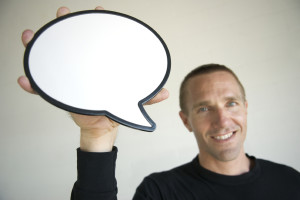 Have you ever heard someone proudly proclaim some version of Popeye’s phrase? It’s most often said to justify themselves right after they’ve said something tactless, or even offensive. Or they might say something like “what you see is what you get”, or “I tell it like it is.”
Have you ever heard someone proudly proclaim some version of Popeye’s phrase? It’s most often said to justify themselves right after they’ve said something tactless, or even offensive. Or they might say something like “what you see is what you get”, or “I tell it like it is.”
People who think this way pride themselves on being brutally honest, as if brutality is a badge of honor.
If I wanted to be brutally honest with them, I would ask them if they were born a–holes, of if they just work hard at it. But of course I don’t, because that kind of brutal honesty, while it might make me feel good, would not help the situation.
The only time to be brutally honest is when you want to hurt someone, when you want to demean that person, or bludgeon them into submission, or prove how much smarter and better you are. I suppose there could be times that would be appropriate, but it’s hard to imagine situations in professional life where that’s going to result in the ideal outcome.
People who talk this way think it displays an admirable independence of spirit, some personal toughness that allows them to be authentic despite social pressures to conform.
What it really displays is a lack of concern for others, selfishness and crass personal manners.
It may also display laziness and/or helplessness. For example, the person who says she’s just not a people person, that she doesn’t play the political game, may just be masking an unwillingness or genuine inability to master the skills needed to work smoothly with others.
Or, they could be laboring under the misimpression that they are stuck with the personality traits they were born with. They think that if they are introverted or analytics, or drivers, or INTJs, or any other label they’ve learned to accept, that their behavior is channeled into a narrow path defined by who they are. Any behavior that crosses those boundaries is “inauthentic”, thus automatically wrong.
Is it “inauthentic” to be tactful? Is it inauthentic to express your ideas so that the other person can best understand your meaning? Is it inauthentic to try to see the world through their eyes? When you look at it this way, inauthenticity is actually a sign of maturity. What makes us effective and influential as adults in a professional environment is precisely our ability to be inauthentic, to dress up our inner selves to go out in public.
Can you go against your normal tendencies if it will leave everyone better off? Clearly, the answer is yes. Just as you choose what to wear depending on where you’re going or what you’re doing, you can choose what to say, how to say it, and what to do. Think about it from the perspective of the other person: they only know who you are by what you say and do. Fortunately, those are the only things you can control; whether you choose to do so is up to you.
It’s a simple choice: be “authentic” or be effective.
The overwhelming trend these days among what’s written about presentations and communications in general is toward visuals and stories to evoke emotions and leave lasting impressions.
That’s a good thing in a lot of ways, especially if it will kill the “wall of words” approach that sadly is still too prevalent in slide presentations today.
But words still count for a lot. In fact, one word can evoke such strong emotions that it overpowers all the context around it. The most glaring example of this in the recent news was Dolphins’ lineman Richie Incognito’s use of the “N-word” in his text message to his teammate Jonathan Martin. Regardless of what comes out of the investigation that is ongoing, the use of that one word has irrevocably changed his life.
Of course most of our daily business and personal communication is not so emotionally charged, but we would do well to continue to pay close attention to the effect that our word choice has on our listeners. Why?
- Words can be as memorable as visuals. Did Obama have a slide showing behind him when he said, “Yes we can?”
- The right combination of words can compress complex thoughts into one memorable phrase:
- “…the only thing we have to fear is fear itself”,
- “If it doesn’t fit, you must acquit”
- Although it’s true that a lot of emotional meaning comes from nonverbal sources such as tone of voice and body language, that assumes face to face communication, which is clearly declining as a proportion of the time that we spend communicating and influencing others. Text, twitter and sound-bites make word choice even more important, because words are all we have.
So What?
Choose your words carefully. Keep in mind that words often carry emotional meaning far beyond their dictionary definitions, which is why armies of political consultants make a living changing gambling to gaming, or inheritance tax to death tax.
Know your audience. Don’t tell a room full of Lanier salespeople during a training class to “Xerox” their sales call plans, as one of my instructors once did.
Use short, simple words. They pack more punch.
Don’t overdo it. Words are so powerful that we use euphemisms to avoid political incorrectness, and sometimes lose clarity. My pet peeve is the horror at using the word “problem” or “weakness” when coaching others. There may be times when someone needs to hear very clearly that they need to solve a problem, not “address an issue.”
Rehearse. When you have to choose your words carefully, don’t count on winging it and being able to confidently say the right thing. I made this mistake once when I was delivering my wrap-up after a two day class to a sales force. I told them they were “pretty good”; two words that negated two days’ worth of enthusiasm—and I couldn’t say a thing to undo the damage.
One of the great—and good—figures of our time passed away yesterday, a man who accomplished so much for his people, his country, and his world.
I will let others far better prepared than I to write about all his accomplishments; I’m just going to focus here on the lesson he leaves for anyone who wants to exert influence on behalf of a cause larger than themselves.
Aristotle told us that the three indispensable tools of persuasion are logos, pathos and ethos—roughly logic, emotion and character. I think those of us who write about these things tend to spend a disproportionate share of ink on the first two—maybe because they are easier to write about, especially in these times when it’s almost politically incorrect to focus on character. That’s a curious omission, considering that Aristotle said that ethos was the most important of the three.
Nelson Mandela spoke with great clarity of logic and force of emotion, but his greatest strength as a persuasive communicator was unquestionably his character.
Aristotle breaks down ethos into three components, common sense, virtue and good will. I submit that Mandela’s towering influence was a result of his clear demonstration of each component.
Common sense: Mandela stood for a clear and simple truth; ten percent of the population could not keep the other 90 percent under its thumb forever, especially in an age of instant and ubiquitous communication. But he also demonstrated common sense in another way, in the sense that he fought for and represented the common aspirations of his people. Unlike many leaders of revolutionary movements, he did not let rigid doctrines or petty squabbles get in the way of the ultimate goal. It’s a lesson our politicians in Washington should learn today—common sense does not reside in the extremes.
Virtue: It’s hard to think of a greater demonstration of virtue than the willingness to spend life in prison for one’s views, and keep in mind that the expected outcome of Mandela’s trial in 1964 was the death penalty, which he was willing to suffer for his movement. In prison he was sometimes treated by the authorities with kid gloves, but he would refuse any special privileges unless his comrades all got the same treatment. He showed he could keep his virtue during the tough times, but perhaps even more surprisingly, he kept it during the good times. He didn’t let power go to his head, surprising the world with his decision not to run for reelection in 1999.
Goodwill: Mandela seemed to delight in Mark Twain’s advice: “Do the right thing. It will gratify some people and astonish the rest.” This was never more evident than in his refusal to harbor (or at least show) any bitterness toward the people who had taken away such a large part of his life. And it wasn’t just the whites; he had to show goodwill to the different factions within the black leadership. Ironically, his given name, Rolihlahla, meant “troublemaker”, but Mandela demonstrated that it was possible to make trouble while maintaining fundamental respect and goodwill toward opponents.
In years to come, when people think of Nelson Mandela, they may not remember any specific things he said, or how he made them feel, but they will surely never forget who he was—because who he was spoke louder than what he said—and that is the perfect embodiment of what Aristotle meant when he said character is the most important factor in influencing others.
One of the favorite statistics cited by communication “experts” is that only 7% of the meaning from spoken communications comes from the actual words spoken. As the story goes, 55% comes from facial expression, and 38% comes from body language, tone of voice, etc.
It has been around ever since Albert Mehrabian cited those statistics in a book entitled Silent Messages, published in 1971.
These experts use it to stress the importance of paying attention to non-verbal signals, whether you are the listener or the speaker. It’s a good statistic to cite because it’s appropriately surprising and it lends an air of science and precision.
The problem with the statistics cited is that it’s mostly false; in my own very unscientific estimate, it’s probably about, oh, let’s say 7% true.
If it were actually true, then when I was in Italy last week, I should have had no problem understanding 93% of what the taxi drivers told me (I didn’t). Plus, I could save a ton of money not buying headphones to watch airplane movies. If it were actually true, then listening to an educational podcast or talking on the phone garners you less than half of the message. And of course, you probably would not be able to understand this article unless I filled it with emoticons, which I refuse to do. It’s so patently untrue that when I read or hear that from someone, I automatically disqualify them as a credible source.[1]
But most people aren’t that simplistic. Some who cite the study come closer to the truth by qualifying it to the part of the message that contains feelings and attitudes. And that definitely makes sense in a lot of communications. If I ask someone how their meeting went, and they answer “great”, I can instantly tell whether they are sincere or sarcastic. In that situation, 0% of the message came from the actual meaning of the word; they could have answered me in Swahili and I would have understood.
But of course it gets more ambiguous as messages get longer, and it definitely does not apply when the speaker is deliberately trying not to show their true feelings. It also does not apply when someone is explaining factual or technical information. If I ask someone for directions, their facial expressions won’t make much difference in my understanding.
So, what did Mehrabian actually measure, and what did he say? Three female speakers were recorded saying one word, “maybe” in either a like, neutral or dislike tone of voice, and then 17 subjects listened to the recordings and were asked to infer what the attitude of the speaker was to a third party to whom they were presumably speaking. A follow-up study was then done with 30 subjects, using nine different words grouped according to the same three attitudes, and the results of both studies were combined to arrive at the statistics cited.
It’s fascinating to me that a study using 10 total words, 47 subjects, conducted in 1967, is still so influential today. As my friends on Sports Center would say, “C’Mon, Man!” (and you can imagine my tone of voice as I say it).
[1] Note: I do not mean to imply any disrespect to Mehrabian or his study, just to people who try to sound scientific without checking their facts.





